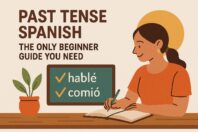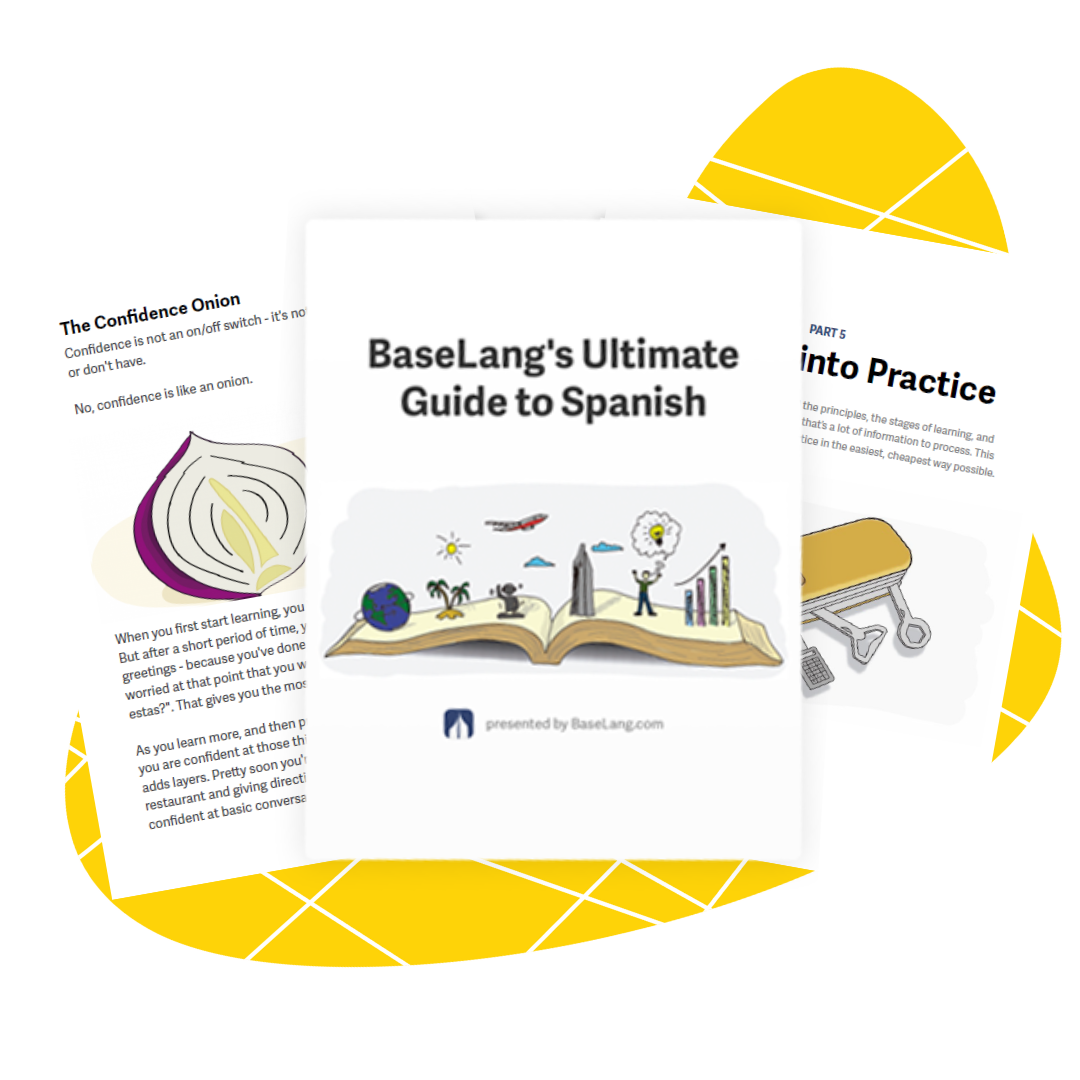The Ultimate Guide to the Present Tense in Spanish

Get our free email course, Shortcut to Conversational.
Have conversations faster, understand people when they speak fast, and other tested tips to learn faster.
More infoAh, the most basic of Spanish conjugations: the present tense.
Conjugations get a bad rep as being super difficult. The reality is, almost every verb follows a predictable pattern, making conjugations pretty straightforward. And since you don’t actually need to learn every conjugation to be conversational (far from it), learning just a few will take you far.
Obviously, the simple present (e.g. I eat, you eat, he eats, they eat) is extremely important.
The Simple Present tense is mainly used to describe habitual actions that occur frequently but the truth is that you can use this tense in many situations, let’s see:
Routine
- Yo cocino en mi casa – I cook at home
- This means cooking is something you usually do.
Action in progress
- Me refiero a otra cosa – I mean the other thing
- You are explaining what you’re talking about. Note, that this is not the same as the -ing form (I’m eating ≠ I eat). Click here to read about the present progressive in Spanish.
Emphatic form
- Yo si como vegetales – I do eat vegetables
- You are confirming that you actually eat vegetables.
Near future
- Yo juego mañana – I play tomorrow
- Even though it’s a future action we can use the present tense to express it.
Simple present structure
We’ll look at the conjugation itself in a second, but here’s how we use it.
Yo + juego + tenis
Subject + Verb in present + complement
Affirmative form:
- Él come vegetales. – (he eats vegetables.)
- Yo trabajo con mi padre en la tienda – (I work with my father in the store.)
Negative form:
- Yo no leo el periódico cada día. – (I don’t read the newspaper every day.)
- Alejando no corre en el maratón. (Alejandro doesn’t run the marathon.)
Questions
- ¿Te gusta la música de Green Day? – (Do you like Green Day’s music?)
- ¿Dónde compras tu ropa? – (where do you buy your clothes?)
Conjugation
To conjugate verbs in simple present we must drop the infinitive ending of the verbs (ar, er, ir) and replace it with the ending according to the pronoun or subject, the root of the verbs stays the same. Here’s what you add when dropping the ending:
| Ar | Er | Ir | |
|---|---|---|---|
| Yo | o | o | o |
| Tú | as | es | es |
| Él, ella, eso | a | e | e |
| Ustedes | an | en | en |
| Nosotros | amos | emos | imos |
| Ellos | an | en | en |
And some examples with real verbs:
| Cantar (sing) | Comer (eat) | Vivir (live) | |
|---|---|---|---|
| Yo | canto | como | vivo |
| Tú | cantas | comes | vives |
| Él, ella, eso | canta | come | vive |
| Ustedes | cantan | comen | viven |
| Nosotros | cantamos | comemos | vivimos |
| Ellos | cantan | comen | viven |
Present Tense Exceptions
Of course, there are always exceptions. I would focus on the regular verbs for now and memorizing the few very important irregulars (these are shown in the next section). So feel free to skip this section if you’re just getting started. If you want to know the exceptions and how they work, though, read on.
Exceptions in the first person singular
- The following verbs are only irregular in the first person singular. In some verbs g must be added before the end of the first person singular. For instance:
| Caer (to fall) | caigo |
| Hacer (to do/make) | hago |
| Poner (to put) | pongo |
| Saber (to know) | sé |
| Valer (to be worth/cost) | valgo |
| Decir (to say) | digo |
- In some verbs ending in er / ir change the last consonant in the first person singular to keep the same pronunciation of the root. For instance:
| the c becomes z | ofrecer – ofrezco |
| the g becomes j | elegir – elijo |
| the gu becomes g | conseguir – consigo |
| the qu becomes c | delinquir – delinco |
- For verbs ending in a vowel or ducir + cer, we must add a z before c in the first person singular, for instance:
| To translate | traducir | traduzco |
|---|---|---|
| To know | conocer | conozco |
Some exceptions are:
| To do/make | hacer | hago |
|---|---|---|
| To swing | mecer | mezo |
| To sew | cocer | cuezo |
Exceptions for the singular and the third person plural
- Some verbs change the vowel of the root. For instance:
| the e becomes i | servir(serve) – sirvo, sirves, sirve, servimos, sirven |
| the e becomes ie | hervir(boil) – hiervo, hierves, hierve, hervimos, hierven |
| the o becomes ue | acordar (agree) – acuerdo, acuerdes, acuerde, acordamos, acuerden |
- In verbs ending in uir, add y before endings that do not begin with i. For instance: Construir – construyo, construyes, construye, construimos, construyen
28 Common Spanish Verbs Conjugated in the Present Tense
In this section we will see how 28 of the most common Spanish verbs are conjugated.
| Comer (to eat) | Cocinar (to cook) |
|---|---|
| (yo) como | (yo) cocino |
| (tú) comes | (tú) cocinas |
| (él) come | (él) cocina |
| (nosotros) comemos | (nosotros) cocinamos |
| (ellos) comen | (ellos) cocinan |
| Bailar (to dance) | Cantar (to sing) |
|---|---|
| (yo) bailo | (yo) canto |
| (tú) bailas | (tú) cantas |
| (él) baila | (él) canta |
| (nosotros) bailamos | (nosotros) cantamos |
| (ellos) bailan | (ellos) cantan |
| Correr (to run) | Dar (to give) |
|---|---|
| (yo) corro | (yo) doy |
| (tú) corres | (tú) das |
| (él) corre | (él) da |
| (nosotros) corremos | (nosotros) damos |
| (ellos) corren | (ellos) dan |
| Dormir (to sleep) | Decir (to say/tell) |
|---|---|
| (yo) duermo | (yo) digo |
| (tú) duermes | (tú) dices |
| (él) duerme | (él) dice |
| (nosotros) dormimos | (nosotros) decimos |
| (ellos) duermen | (ellos) dicen |
| Enseñar (to teach) | Escribir (to write) |
|---|---|
| (yo) enseño | (yo) escribo |
| (tú) enseñas | (tú) escribes |
| (él) enseña | (él) escribe |
| (nosotros) enseñamos | (nosotros) escribimos |
| (ellos) enseñan | (ellos) escriben |
| Escuchar (to listen) | Estudiar (to study) |
|---|---|
| (yo) escucho | (yo) estudio |
| (tú) escuches | (tú) estudias |
| (él) escucha | (él) estudia |
| (nosotros) escuchamos | (nosotros) estudiamos |
| (ellos) escuchen | (ellos) estudian |
| Hablar (to speak) | Hacer (to do/make) |
|---|---|
| (yo) hablo | (yo) hago |
| (tú) hablas | (tú) haces |
| (él) habla | (él) hace |
| (nosotros) hablamos | (nosotros) hacemos |
| (ellos) hablen | (ellos) hacen |
| Ir (to go) | Jugar (to play) |
|---|---|
| (yo) voy | (yo) juego |
| (tú) vas | (tú) juegas |
| (él) va | (él) juega |
| (nosotros) vamos | (nosotros) jugamos |
| (ellos) van | (ellos) juegan |
| Leer (to read) | Llamar (to call) |
|---|---|
| (yo) leo | (yo) llamo |
| (tú) lees | (tú) llamas |
| (él) lee | (él) llama |
| (nosotros) leemos | (nosotros) llamamos |
| (ellos) leen | (ellos) llaman |
| Llorar (to cry) | Mirar (to show/watch) |
|---|---|
| (yo) lloro | (yo) miro |
| (tú) lloras | (tú) miras |
| (él) llora | (él) mira |
| (nosotros) lloramos | (nosotros) miramos |
| (ellos) loran | (ellos) miran |
| Preguntar (to ask) | Reir (to laugh) |
|---|---|
| (yo) pregunto | (yo) río |
| (tú) preguntas | (tú) ríes |
| (él) pregunta | (él) ríe |
| (nosotros) preguntamos | (nosotros) reímos |
| (ellos) preguntan | (ellos) ríen |
| Sentir (to feel) | Ser (to be) |
|---|---|
| (yo) siento | (yo) soy |
| (tú) sientes | (tú) eres |
| (él) siente | (él) es |
| (nosotros) sentimos | (nosotros) somos |
| (ellos) sienten | (ellos) son |
| Sonreir (to smile) | Tener (to have) |
|---|---|
| (yo) sonrío | (yo) tengo |
| (tú) sonríes | (tú) tienes |
| (él) sonríe | (él) tiene |
| (nosotros) sonreímos | (nosotros) tenemos |
| (ellos) sonríen | (ellos) tienen |
| Trabajar (to work) | Vivir (to live) |
|---|---|
| (yo) trabajo | (yo) vivo |
| (tú) trabajas | (tú) vives |
| (él) trabaja | (él) vive |
| (nosotros) trabajamos | (nosotros) vivimos |
| (ellos) trabajan | (ellos) viven |
Spanish Present Tense Practice
Choose the correct sentence based on the image.
- Ella habla por teléfono todos los días.
- Ellos hablan por teléfono todos los días.
- Nosotros hablamos por teléfono todos los días.
- El habla por teléfono todos los días.
- ¿El escucha música?
- Ella escucha música.
- Ustedes escuchan música..
- Ellos escuchan música.
- Él mira a través del lente.
- Ustedes miran a través del lente.
- Ella mira a través del lente.
- Tú miras a través del lente.
- Ellos cocinan la cena.
- Él cocina la cena.
- Ella cocina la cena.
- Ustedes cocinan la cena.
- El bebé llora.
- Ellas lloran.
- Ustedes lloran.
- Nosotros lloramos.
KEY
- Ella habla por teléfono todos los días.
- Ella escucha música.
- Él mira a través del lente.
- Él cocina la cena.
- El bebé llora.
There’s a lot here, but remember that 90%+ of verbs follow the very simple rules laid out earlier. With a little practice (you need to actually speak and use this if you want it to flow naturally), you’ll have it down.








